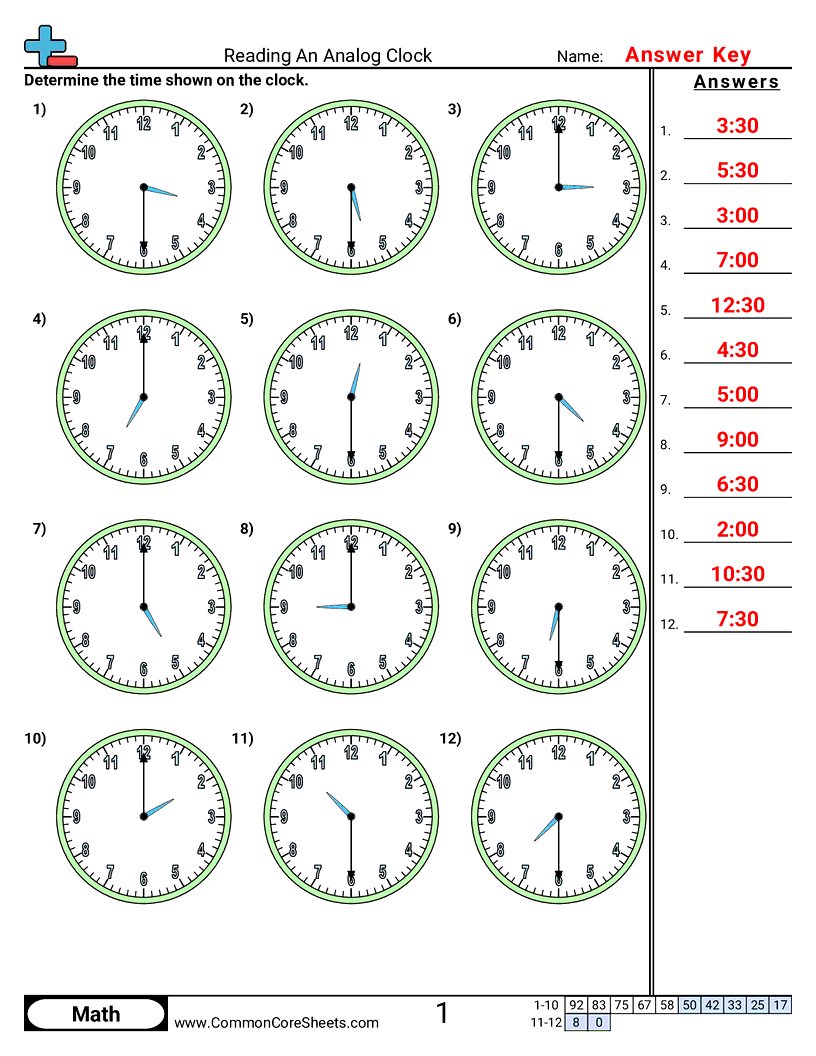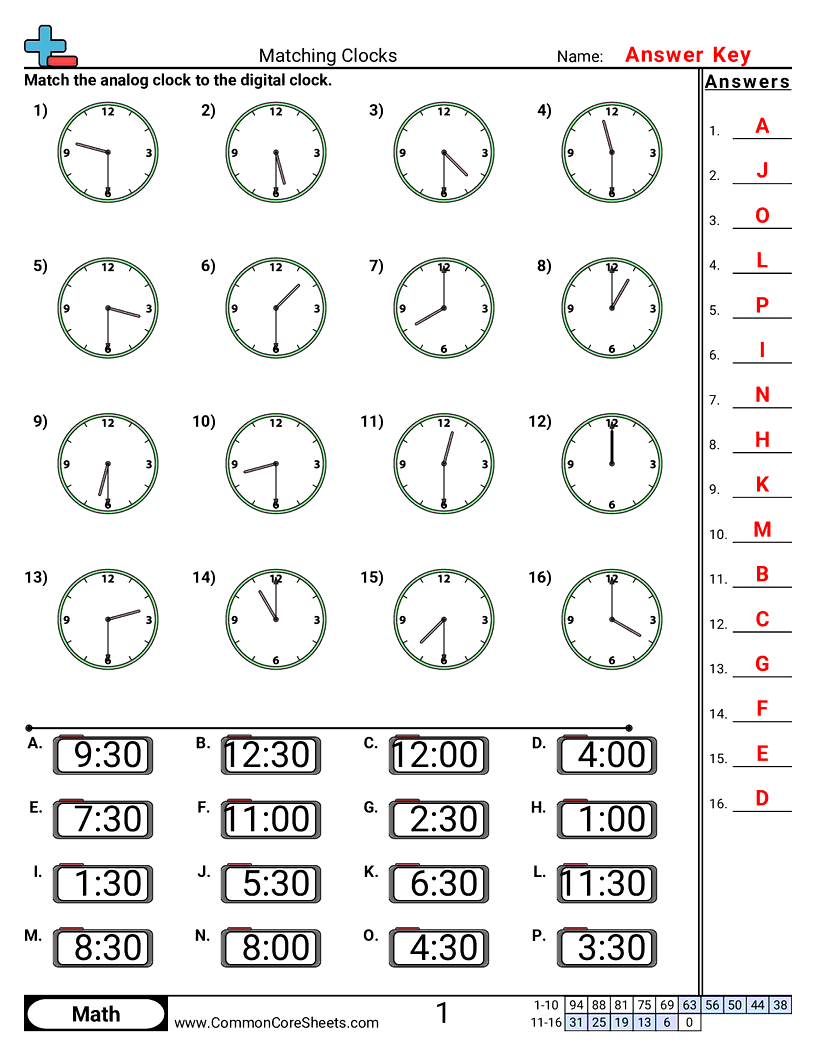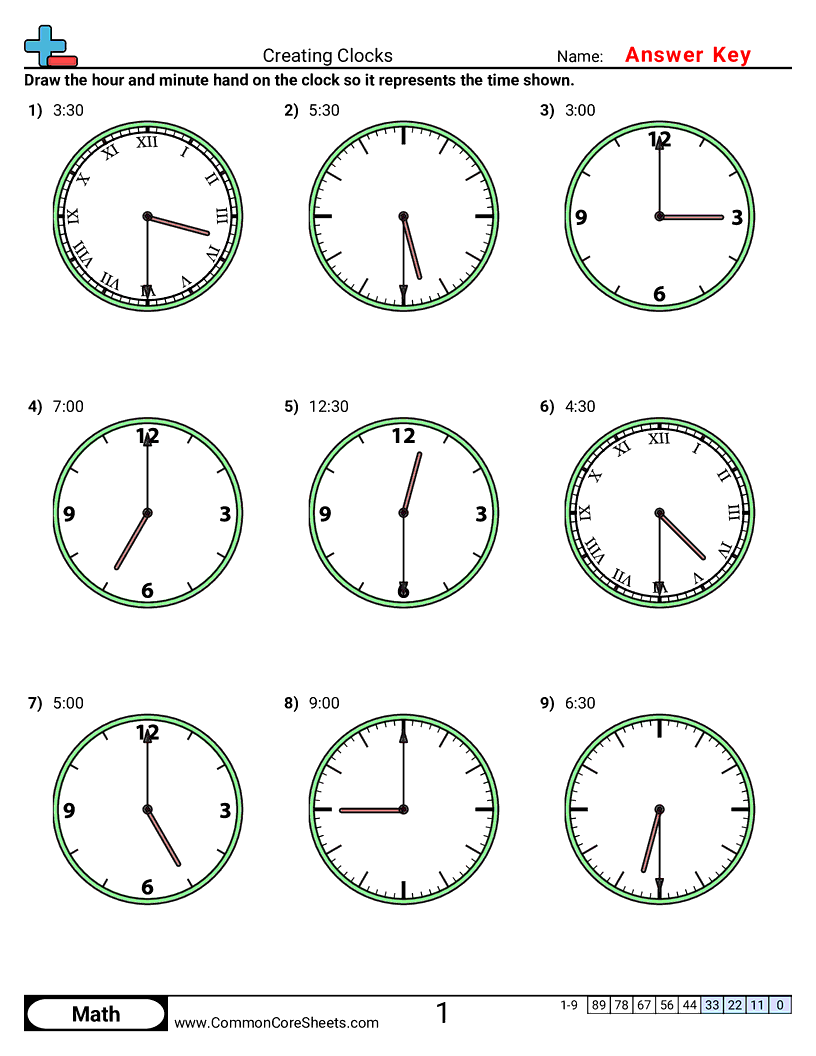Free time worksheets with answer key. No login or account needed. Our worksheets are perfect for teaching students to read a clock, calculate elapsed time, solve start and ending times, and tackle time word problems. A grading column and quick grade scale maker grading a breeze and a modified pages help with lower level learners or when just introducing a topic. Great for teachers or for homeschool.
Browse Sheets By Problem Type
×

1md3


×
Description:
"This worksheet is designed to enhance children's understanding of reading an analog clock. With a total of 12 math-related problems, the exercises involve conceptualization of the traditional time-telling system. This flexible resource is customizable to meet various learning needs, and can be converted into flashcards for an engaging learning experience. It's also suitable for distance learning, facilitating seamless accessibility and intuitive learning for students wherever they are."

×
Student Goals:
Understanding Time ConceptsAfter successfully completing this worksheet, students should have a solid understanding of analog clock reading. They should be familiar with the positions of the hour and minute hand on a clock face and be able to correlate these positions to specific times. They will also get to understand the concept of elapsing time by interpreting the movement of the clock hands.Practical ApplicationBeyond theory, students will be able to apply what they have learned in this mathematical exercise to real-life situations. The ability to tell time underpins many aspects of daily life, from being punctual for appointments to knowing when to perform daily tasks. Consequently, they will be able to manage their time properly and effectively, strengthening their overall time management skills.Problem SolvingBy practicing these analog clock problems, students will sharpen their problem-solving skills. They will learn to interpret the information provided on the clock and translate that into understandable time formats. By addressing different problems, they will also improve their analytical thinking abilities, learning how to approach and solve varying problems in time-related exercises.Boosting ConfidenceSolving analog clock reading problems can sometimes be challenging, but once students are able to easily solve these problems, it will foster confidence in their mathematical abilities. Any hesitation or nervousness about reading analog clocks would have been addressed and overcome, making them more comfortable with time-telling tasks.Numeracy SkillsThe worksheet will contribute greatly to enhancing students' overall numeracy skills. It will help them improve their number recognition as well as their mental arithmetic, since time-telling often involves a good grasp of numbers and calculations. Additionally, it will build their foundational knowledge for more complex math topics and operations.Fostering IndependenceLastly, this worksheet will foster a sense of independence and self-reliance in the students. As they become adept at telling time, they'll need to rely less on digital devices and others to organize their day or know the time. This is a vital skill that will help them in becoming more self-sufficient and capable, enhancing not only their academic competency but their life skills as well.



1md3


×
Description:
"This worksheet is designed to reinforce children's understanding of time. Titled 'Matching Clocks,' it offers 16 math problems that challenge students to pair time expressions with corresponding analog clock faces. With its adaptable format, it can be customized to fit varying curricula, converted into interactive flashcards for hands-on learning or implemented in distance education programs to support academic continuity during remote learning situations."

×
Student Goals:
Enhanced Time UnderstandingPost completion of 'Matching Clocks', students will exhibit an improved understanding of how time works. Reading analog clocks will become second nature to them. Converting the analog time to digital becomes easier and errors are minimized. They understand all 12 hours of the clock and how to distinguish 'AM' from 'PM'.Improved Arithmetic SkillsAs this worksheet involves a lot of counting, addition and subtraction, students will have a greater handle on their basic arithmetic abilities. The repetitive practice will instill in them the know-how of quickly calculating time differences.Enhanced Analytical ThinkingThe matching process requires a good deal of logic and rational thought. Students will need to engage their analytical thinking capabilities to correctly pair the clocks with their corresponding times. This repeated exercise over 16 problems augments their analytical capabilities.Develop Time Management SkillsIn real-time situations, the ability to read a clock is directly linked with one's time management skills. By being able to calculate the time and time differences, students can learn to manage their schedule and activities better.Strengthened Problem-Solving AbilitiesThe worksheet equips students with better problem-solving abilities. They need to figure out the correct match for each clock from multiple options, which helps in enhancing their decision-making and problem-solving skills.Increased Accuracy and SpeedThrough repetitive practice of this worksheet, students will get more precise and faster in matching times. The speed and accuracy gained will prove beneficial for them not only in solving academic math problems but also in processing time in day-to-day life.Boosted ConfidenceUpon successfully completing the worksheet, students should feel a sense of achievement. This success can provide a vital confidence boost, stimulating them to take on more challenging math problems and tasks.Greater Academic PerformanceMastering over time reading improves the students' overall math ability. This improved ability reflects positively not only in their math grades but also contributes broadly in other subjects requiring time management or time-estimation tasks.



1md3


×
Description:
"This worksheet is designed to help children master the concept of time through the engaging activity of creating clocks. It includes 9 math problems that each present a different time of day. The worksheet offers flexibility for all learning styles and environments—it can be customized to meet individual student needs, converted into flash cards for hands-on learning, or used in distance learning scenarios. An excellent resource for developing essential math skills in a fun, intuitive way."

×
Student Goals:
Understanding Clock FacesAfter completing the worksheet, students should acquire a clear understanding of how traditional clock faces work. Familiarity with the relationship between the short and long arms of the clock and how they denote hours and minutes will allow for error-free interpretation of the time. Through visual recognition of the difference between half-past and o’clock times, they can better understand the concept of time passage.Building Time Telling SkillsAdeptness in telling time on both analog and digital clocks is an essential milestone in children's mathematical learning. By completing the problems provided, they should develop a proficiency in translating time from paper to an actual clock. With improved skill levels, students should not only tell time accurately but also be able to make reasonable estimates about the duration of various events and activities.Enhancing Problem-Solving CapabilitiesUnderstanding the placement and movement of the clock hands enhances children's problem-solving ability. When given a specific time, they should be able to determine the position of each hand on the clock independently. These exercises train children's minds to think logically and solve problems, skills that generalize beyond this specific task.Developing Time Management AwarenessBeing able to tell time accurately is the first step to developing beneficial skills such as time management. As students understand time's passage, they also become aware of life's rhythms and the need for planning and scheduling. Upon completion, students should demonstrate an emerging appreciation for timely task completion.Boosting Math ConfidenceSuccessfully solving time-related problems boost students' confidence in their mathematical abilities. Each correct answer they arrive at, fosters a can-do attitude towards math and instills belief in their quantitative skills. This practice work should help them transition from guided support to independent problem solving in various mathematical contexts, hence encouraging continuous mathematical exploration.




